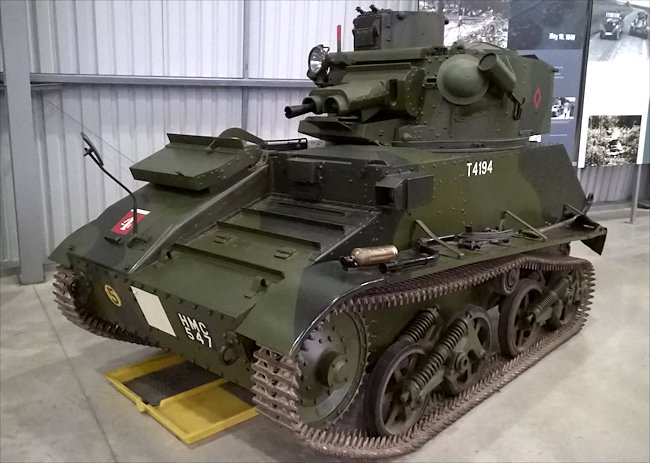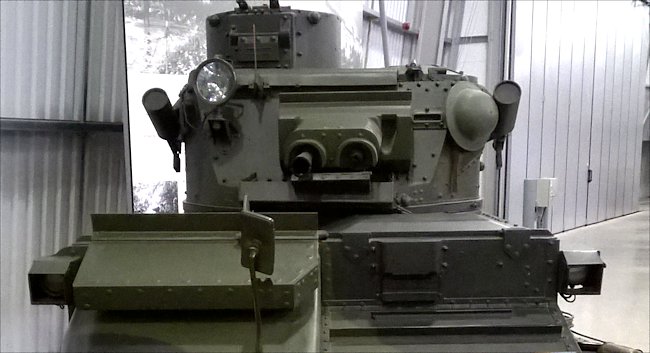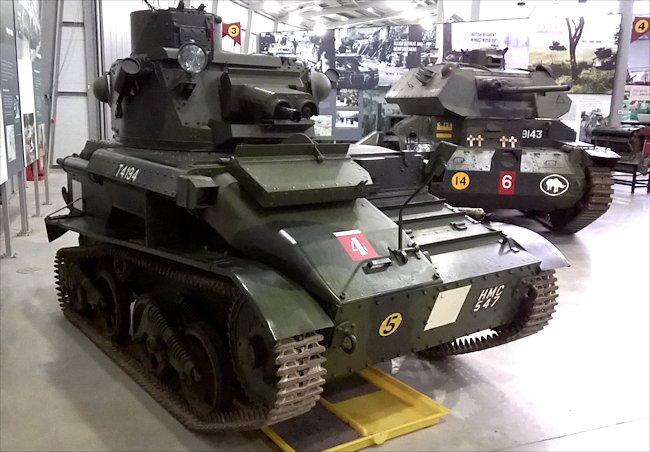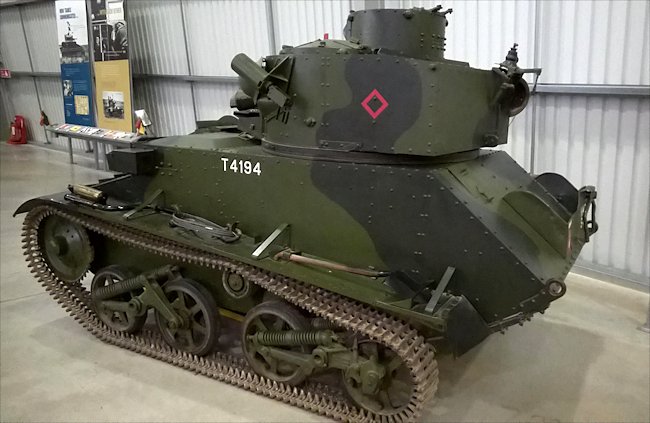Vicker's MkVI B Light Tank
This surviving British Expeditionary Force WW2 British Vickers Light Tank MkVI B can be found at the Tank Museum, Bovington, Dorset, England. They were outclassed by the German Panzer Mk III tank. Most were left at Dunkirk during the evacuation of the BEF.

Vickers MkVI B Light Tank at the Tank Museum, Bovington
Location
This Vickers Light Tank MkVI B is on show at the Tank Museum, Linsay Road, Bovington, Dorset. The nearest train station is Wool Railway Station. You can walk the 2 miles to the Museum but there are not pavements along the country road and if you are travelling with children it can be dangerous. It takes 45 minutes by foot. There is an irregular bus service from Wool Station that will get you to the museum but they only come once an hour in the morning starting after 9.30.
The last bus back to the station from the Tank Museum is just after 13.45 which is really silly. There is no Sunday bus service. The easiest way to get to the museum from the train station is by taxi. They can be pre booked with Garrison Cars to meet you when your train arrives and pick you up for the return trip from outside the museum. Their phone number is 01929 463395
Specifications
The Vickers Light Tank Mk VI was in front line service from 1936 to 1942. It was in production by Vickers-Armstrong from 1936 to 1940. Around 1682 were built. This light tank required a crew of three: commander, Gunner and driver. The armour thickness ranged from 4 mm to 14 mm which was just enough to protect the crew from small arms fire and shrapnel. It did not have a gun that was capable of firing armour piercing shells. It was only armed with a .50 inch Vickers Machine Gun (Mk VIC 15 mm Besa machine gun) and an additional .303 inch Vickers machine gun (Mk VIC 7.92mm Besa Machine Gun).
It was powered by a Meadows 6 cylinder 4.4 litre petrol engine that produced 88 hp. Its maximum road speed of 35 mph (56 km/h) was fast. Its off road speed maximum was 25 mph (40 Km/h) and it had an operational range of 130 miles (210 km) before the crew needed to refuel the tank. For a tank it had good fuel consumption figures of 3.8 mpg (10.7 litres per Km). It weighed 5.2 tons.

There are smoke dischargers on both sides of the Vickers MkVI B Light Tank's Turret
Bovington's Vickers MkIV B Light Tank
Bovington Tank Museum staff do not believe their tank saw active service. It is believed it was used for tank crew training but the place of manufacture on this tanks manufacturer's plate has been ground off. This was done to prevent the enemy knowing what town to send their bombers to if the tank was captured or knocked out. At some time in its history it was prepared to go to war.
it was one of the first tanks to be fitted with smoke grenade dischargers. You can see them on both sides of the tank turret. When a tank came under direct enemy fire the commander would order 'smoke' and the dischargers would fire their canisters up wind in front of the enemy's position. The wind would then help move the smoke to provide a smoke screen to allow the tanks to make their escape and get out of range of the enemies guns or seek cover. Smoke dischargers are still used on tanks today. If you cannot see a tank it is difficult to hit it.

The Vickers MkVI B Light Tank was only armed with two machine guns
The design of the Vickers light tank MkVI B was originally worked out by Vickers Armstrong. They built some of the early ones. It was one of the first British tanks to be mass produced at different locations before the Second World War. Companies that had been building railway engines, lorries and cars came together to construct these new tanks in large quantities.
It has a maximum armour thickness of 14 millimetres which would only protect the crew from small arms fire and shrapnel. If you look at the armour closely, although it is of riveted construction not welded, you will find that it has been skillfully put together. All the armour plates have been filed to perfection so that they butt up to each other with no tiny gaps. You could not put a cigarette paper between them unlike on earlier tanks.
This was done to prevent metal splash inside the tank injuring the crew. Metal splash had been the big problem in the First World War tanks. When armour plates were not made that well or fitted together properly, hot liquid lead from enemy machine-gun and rifle bullets would seep into the crew compartment at high speed causing injury. Making the armour plates fit as close as physically possible slow down the production process but gave better protection for the crew.

The Vickers MkVI B Light Tank's armour thickness only ranged between 4 mm to 14 mm
Unusually for a British tank the tracks are driven from the front by the large front drive sprocket. Unusually for a British tank the driver sat on the left-hand side of the vehicle at the front. The protective armour in front of the driver could be opened up. The top section hatch would open above the driver’s head and the bottom section covering the driver’s hands would flip forward increased his vision when on manoeuvres away from the front line.
There were two crewmen in the turret, the commander and gunner. This wasn’t the first three-man British tank but it was the first three-man British tank that was produced in large numbers. The Vickers MkVI B light tank was not fitted with a gun that could fire armour piercing shells. The .50 inch Vickers Machine Gun (Mk VIC 15 mm Besa machine gun) was considered powerful enough to be an anti-tank gun when this tank was first designed. The armour fitted to potential enemy tanks in 1936 could be penetrated by this weapon. Unfortunately for the tank crews that manned this vehicle new German and Italian tank designs had much thicker armour by the start of World War II.
Both machine guns fitted side-by-side in the turret. There was no machine-gun fitted to the hull of the tank. Each machine-gun was fired separately. One person could not fire both machine guns at the same time when on the battlefield.
The Vickers MkVI B light tank are quite reasonable top speed but one of the problems with the suspension was that it tended to buck up and down like a Bronco horse at a rodeo giving a very uncomfortable ride for the crew. This made it difficult to fire on the move. There is a strange rectangular box on the upper part of the front hull on the right side. It was an armoured cover for the air cooling system that would allow fresh air in but not bullets.
Something that is often overlooked when historians compare this tank with the Panzer II, III and IV tanks of the invading German army in France 1940 it was only meant to be a light reconnaissance vehicle, not a main battle tank. As a fighting tank against other tanks they were absolutely useless. They were designed to rush ahead and find out the enemy’s location then retreat as fast as they can without engaging enemy armour. They could engage soft skin targets and infantry but there thin armour would not protect them from handheld anti-tank weapons.
Even though they were obsolete by the start of World War Two they fought with the British Expeditionary Force in France and Belgium in 1940 against the Germans, in the Western Desert of North Africa it was up against the Italian Army as well as the German Afrika Korps and later the Japanese in the jungles of Java. They were also used by the Indian army. Generally the Vickers MkVI light tank was very reliable, mobile quite fast but as a tank on tank fighting machine no good at all.
World War Two Books

